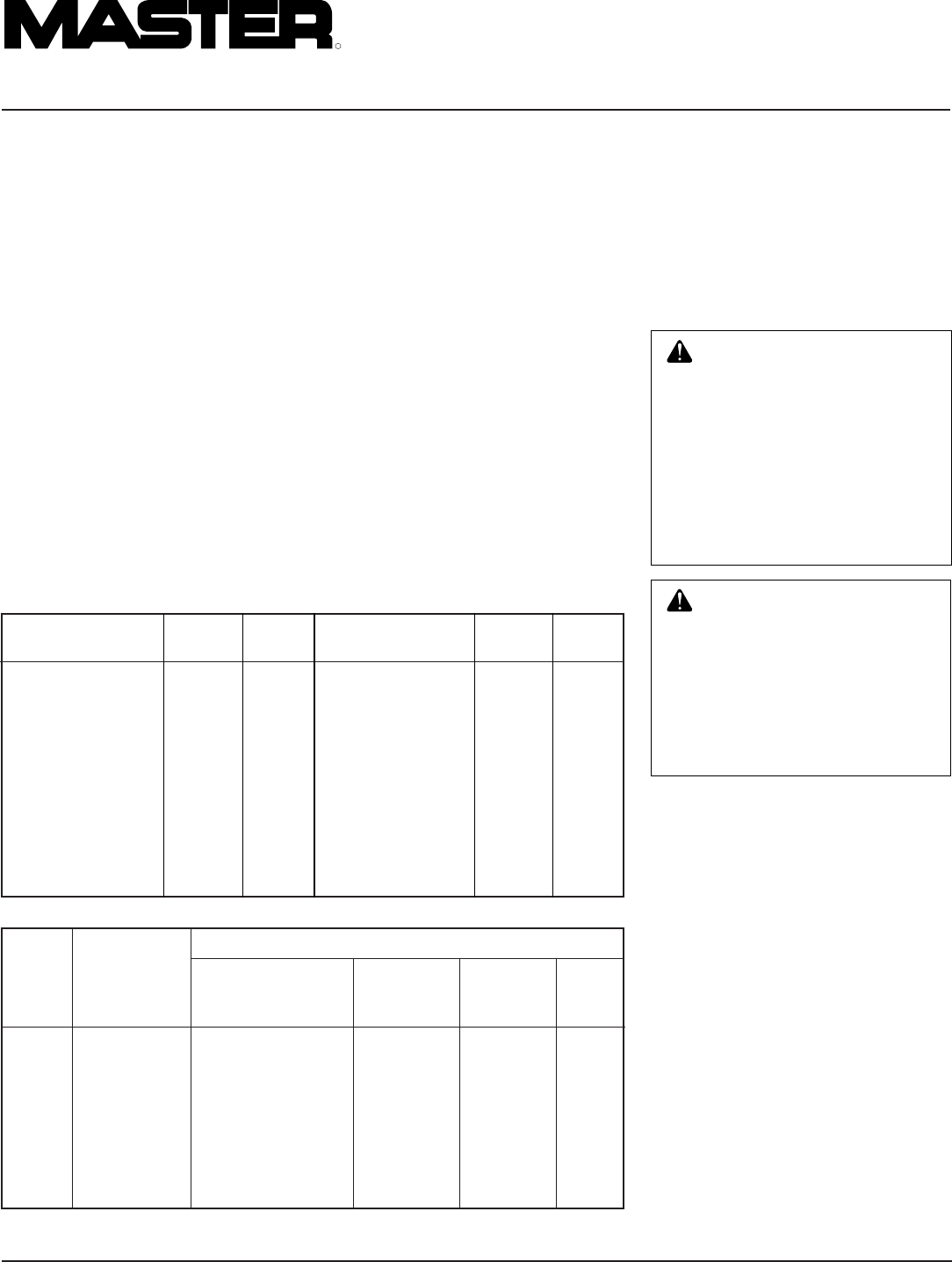
10
105420
PORTABLE GASOLINE GENERATORS
R
OPERATION
GENERAL INFORMATION
This generator is not large enough to power
your entire home. Do not connect generator
to any existing electrical circuits. Plug items
directly into generator receptacles. Do not
exceed amperage rating of receptacles. Only
use grounded cords.
Running Starting
Equipment Watts Watts
1/2" Drill 1000 1250
Toaster 1200 1200
Coffee maker 1200 1200
Skillet 1200 1200
14" Chain saw 1200 1500
Water well pump
(1/2 hp) 1000 3000
Hot plate/range
(per burner) 1500 1500
10" Table saw 2000 6000
Water heater
(storage-type)
5000 5000
Running Starting
Equipment Watts Watts
Light bulb (100W) 100 100
Radio 150 150
Fan 200
600
Television 400 400
Furnace fan
(1/3 hp)
with blower 600 1800
Vacuum cleaner 600 750
Sump pump
(1/3 hp)
700 2100
Refrigerator/freezer 800 2400
6" Circular saw 800 1000
Floodlight 1000 1000
3. Electric motors present a special problem.
They require up to three-times their rated
wattage to start. Chart 2, below, shows
starting watts for different size motors. For
example: an electric motor nameplate
states 5 amps at 120 volts. 5 amps x 120
volts = 600 watts running. Multiply this
figure by 3. This will show the starting
watts needed. 600 watts x 3 = 1800 watts
to start. When figuring the generator load
for motors, you must use the starting watts
figure. Do not use the running watts fig-
ure.
Note:
Some motors require nearly the
same wattage to run as to start. These items
include saws, drills, hair dryers, and food
mixers. See Chart 1 for typical appliance
wattage examples.
4. Add watts and starting watts of all items.
This total must not be larger than the rated
wattage of your generator. It is a good
idea to have up to 25% extra capacity for
future needs or extra equipment.
Approximate Starting Watts*
Motor Approximate Universal Repulsion Split
HP Running Motors Induction Capacitor Phase
Rating Watts (small appliance) Motors Motors Motors
1/8 500 625 1100 1500 2250
1/4 700 875 1550 2100 3150
1/3 800 1000 1750 2400 3600
1/2 1100 1375 2400 3300 4950
3/4 1400 1750 3100 4200 x
1 1700 2125 3750 5100 x
1 1/2 2100 2625 4620 6300 x
2 2450 3075 5400 7350 x
3 3600 x 7900 10800 x
Chart 2
* – Always use starting watts, not running watts, when figuring correct electrical load.
x – Motors of higher horsepower are not generally used.
Chart 1 - Typical Electric Appliance Wattages
1. Make two lists of items you want pow-
ered by generator. List all motors and
motor powered appliances in one. List all
lights, small appliances, etc. in the other.
For standby service to home or building,
only include items you must power.
2. Enter running watts of each item except
motors. The light bulb or appliance name-
plate lists its wattage. Remember, 1KW
= 1000 watts.
Note:
The nameplate may
not list wattage. It may only list volts and
amps. The formula for finding wattage
is: Volts x Amps = Watts. For example:
An appliance nameplate states 3 amps at
120 volts. 3 amps x 120 volts = 360 watts.
DANGER: Never connect gen-
erator to any existing electrical
circuits. The generator output will
back-feed into the utility power
line. This may electrocute a power
company line repair person. Also,
if generator is powering electri-
cal circuits, the chance of an elec-
trical fire exists.
Note:
We supply the engine owner’s manual
with generator. Refer to that manual for
questions concerning engine operation.
USING RECEPTACLE
Note:
Do not exceed amperage rating of
receptacles. Exceeding rating will trip re-
ceptacle circuit breaker.
Use receptacles properly. Improper use could
damage generator. Use only grounded exten-
sion cords. Power only grounded or double-
insulated items. Do not overload receptacles.
All generators (except models HWI3000,
MGH3000, and MGH3000PR) have the fol-
lowing receptacles (see Figure 15):
• 120V, 15-amp GFCI duplex receptacle
• 120V, 30-amp twist-lock receptacle
• 120/240V, 20 or 30-amp twist-lock
receptacle
• 120V, 15-amp duplex receptacle
DANGER: Use only in well-
vented areas. Make sure area has
plenty of free-moving, fresh, out-
side air. Never run generator in
an enclosed or confined area.
Never run generator inside occu-
pied building. Engine exhaust
contains poisonous carbon mon-
oxide gas. Overexposure will
cause loss of consciousness and
will lead to death.
DETERMINING
ELECTRICAL LOAD
FOR GENERATOR
Continued
